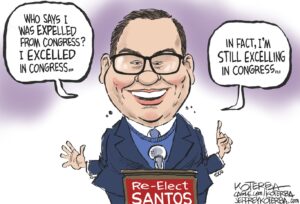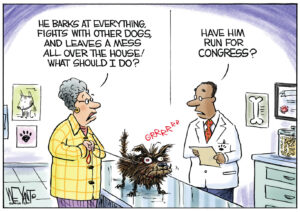The Vital Incoherent Center
Here's one political paradox: A substantial majority of Americans do not fit neatly into the conventional "liberal" and "conservative" boxes, yet there is no coherent political center. Those who dream of a middle-of-the-road third party are destined to be disappointed. Dirk Loop (CC-BY)
Dirk Loop (CC-BY)
Here’s one political paradox: A substantial majority of Americans do not fit neatly into the conventional “liberal” and “conservative” boxes, yet there is no coherent political center. Those who dream of a middle-of-the-road third party are destined to be disappointed.
Here’s another: Groups broadly sympathetic to the Democratic Party significantly outnumber those sympathetic to the Republican Party. But in the smaller but influential universe of the ideologically committed, conservative Republicans outnumber liberal Democrats. The larger Democratic coalition has mixed convictions while the smaller Republican core is filled with passionate intensity.
Every decade or so, the Pew Research Center sorts the American electorate into discrete groupings with interesting names. Pioneered by the legendary pollster Andrew Kohut in 1987, the political typology helps clarify reality by making the complexity of public opinion understandable. Voters aren’t “inconsistent.” They just don’t conform to a pre-fabricated left-center-right world.
Pew’s latest map of public opinion finds the electorate divided into eight groups. One of them, “Bystanders,” consists of Americans simply disconnected from politics. Three groups are the “anchors” of partisanship: “Steadfast Conservatives” and “Business Conservatives” are the bedrock of the Republican Party, while “Solid Liberals” are staunch Democrats.
The Republican “anchors” reflect the fundamental split in the GOP. The Steadfast group is conservative across the board, while the Business group is more pro-immigration and pro-Wall Street. This split does not overlap with the conflict over the tea party, since both groups are about equally partial to the movement. At the other end, Solid Liberals are, as their name suggests, “liberal across the board” on major issues.
The two conservative groups constitute 22 percent of the general public (12 percent in the Steadfast category, 10 percent in the Business camp) while Solid Liberals account for 15 percent. The conservative lead widens (27 percent versus 17 percent) among registered voters, and it’s wider still among politically engaged Americans — 36 percent of them belong to the conservative groups, only 21 percent to the liberal one.
So if you wonder why Republicans have a hard time being moderate or conciliatory, the answer is clear enough: The bulk of their support comes from tuned-in, ideological conservatives. In the Democratic coalition, liberals are important but not dominant.
So why aren’t Republicans sweeping the country? The explanation can be found in the political center, and Pew has bad news for those searching for a vital middle-ground politics. The center, the report finds, is “fragmented” because “there are many distinct voices in the center, often with as little in common with each other as with those who are on the left and the right.”
And it’s in the center where Democrats enjoy a major advantage. Of the four “less partisan, less predictable” groups, three lean Democratic.
The “Faith and Family Left” (15 percent of the electorate) is racially diverse, religious, pro-government and tilts socially conservative. The “Hard-Pressed Skeptics” (13 percent) are financially stressed pessimists who believe in government programs, preferred President Obama by a 40-point margin in 2012, but now lean Democratic in this fall’s congressional races by only 14 points. The “Next Generation Left” (12 percent) is made up of younger social liberals who support an activist government but worry about the cost of social programs.
The “Young Outsiders,” the sole Republican-leaning center group, have conservative views on government and economics but not on social issues and constitute 14 percent of the public.
Combining all of Pew’s categories, the pro-Republican groups add up to only 36 percent of the public, the pro-Democratic groups to 55 percent. (The rest are Bystanders.) Among registered voters, the Democratic-leaning groups have an edge of about 3-to-2 over the Republicans.
So why don’t Democrats win every election? We are back to intensity and to the fact that middle-ground Democratic groups have qualms about the party they lean toward. For 2014, the GOP groups are mobilized and largely united. Democrats, the survey found, are suffering a fall-off from their 2012 margins, particularly among the Hard-Pressed Skeptics and the Faith and Family crowd.
These numbers suggest that the outcome in November will depend in large part on the Democrats’ ability to strengthen themselves among voters still hurting economically — one reason Obama is having so many town halls in the heartland this summer — and to boost both turnout and support among the Faith and Family voters.
The bottom line: Republicans are prisoners of an older, deeply conservative base. The Democrats are hostage to a politically diverse but easily splintered coalition. And good luck to those trying to find a viable center.
E.J. Dionne’s e-mail address is ejdionne(at)washpost.com.
© 2014, Washington Post Writers Group
Your support matters…Independent journalism is under threat and overshadowed by heavily funded mainstream media.
You can help level the playing field. Become a member.
Your tax-deductible contribution keeps us digging beneath the headlines to give you thought-provoking, investigative reporting and analysis that unearths what's really happening- without compromise.
Give today to support our courageous, independent journalists.






You need to be a supporter to comment.
There are currently no responses to this article.
Be the first to respond.